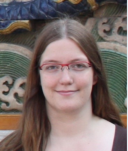 This thesis explores a novel catalyst support design. ‘The application potential served as an inspiration,’ Joline Roemers-van Beek says. ‘Carbon nanofibers on structured supports could well improve ceramic structured catalyst supports, for example monoliths in cars, and make them suitable for efficient catalyst recycling.’
This thesis explores a novel catalyst support design. ‘The application potential served as an inspiration,’ Joline Roemers-van Beek says. ‘Carbon nanofibers on structured supports could well improve ceramic structured catalyst supports, for example monoliths in cars, and make them suitable for efficient catalyst recycling.’
In the design - proposed by the Catalytic Processes & Materials (CPM) Group - a macro-porous basis is used to immobilize a layer of carbon nanofibers (CNFs) agglomerates, with the possible addition of a grown CNF binder layer.
‘Fundamental questions on the initiation of CNF growth on polycrystalline nickel had to be explored first,’ Joline states. After that, a catalyst support structure was produced, by immobilizing a layer of CNF agglomerates on a stainless steel filter through filtration. Different ways to increase attachment of the immobilized CNF layer to the stainless steel filter were attempted, e.g. increased pressure drop, densification, and an additional binder layer.
Also, a palladium-loaded, immobilized CNF agglomerates layer, on a stainless steel filter, was tested for catalytic hydrogenation of nitrite. Activity and selectivity in nitrite hydrogenation were studied, by varying several parameters, e.g. CNF particle size, CNF particles loading, and flow regime.
To answer the fundamental questions, CNF growth experiments were performed under atmospheric pressure with extremely diluted ethylene (50 Pa), coupled to ex-situ characterization in high-resolution Scanning Electron Microscopy, X-ray diffraction and Raman spectroscopy.
Additionally, in-situ experiments were conducted, under low pressure conditions, in an Environmental Scanning Electron Microscopy (ESEM) introducing very low quantities of ethylene in the chamber.
Isolating layer
‘It was shown that an isolating layer of unreduced NiO is needed between the Ni bulk and the Ni nanoparticles, to enable CNF growth,’ says Joline.
Experimental work and emerging theoretical issues alternated during her PhD project, Joline explains. ‘We had to be sure first why our initial thoughts about attaching the fibres onto the layers, proved different as we had assumed,’ Joline says. ‘A more direct catalyst/binder layer design approach, proved preferable. We had to ensure ourselves of that, by clever experimentation and by searching for theoretical explanatory backgrounds.’
Berlin
Joline visited the Fritz Haber Institute in Berlin several times. ‘Here, we were able to use the specially built Environmental Scanning Electron Microscope,’ she says. ‘This allowed us to experiment under both high- and low-vacuum conditions while introducing gasses to the sample, to perform in situ experiments, which were very clarifying for our understanding of the processes involved.’
Joline collaborated with partners from both academia and industry. ‘In total seven partners were involved,’ she says. ‘A fellow-PhD at the University of Delft worked parallel on this theme, focusing on modelling and simulation aspects. With our industry partners - including Shell, Dow and Sulzer - we had several progress discussions, leading to mutual understanding. I learnt that sometimes it is wise to take one step back, in order to secure progress steps later on.’
Different cultural backgrounds
Collaborating with researchers from different cultures, Joline appreciated very much.
‘For example, Chinese colleagues find it hard to cope with our direct personal approach,’ she says. ‘I learnt to interpret and appreciate their way of reasoning and argumentation. And, I now check my own Western cultural bias, by asking if I interpreted their explanation and vision fully and correctly.’
All-round research
As a future job, Joline prefers to work in a small company.
‘I assume the working atmosphere to be less anonymous than in bigger companies,’ she says. ‘And I like to work in an independent way, meeting all kinds of facets, as an all-round research fellow. Also, I would like to see the fruits of my work, being of direct use in the products, for customers.’
‘As I would like to stay in Twente, I am exploring options at one of Mesa+’s spin-off companies, for example Solmates. This company is ambitious, to position pulsed laser deposition (PLD) as a mainstream technology.'
